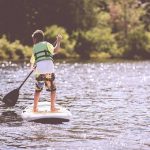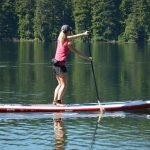If you’re trying to decide whether to get a standup paddleboard or a kayak, you came to the right place. SUPs are relatively new but are growing in popularity quickly, while kayaks remain popular around the world.
We should clarify what these two hobbies are before we start.
Other than the fact that all three activities take place on the water, kayaking, canoeing, and standup paddle boarding (SUP) have little in common. Kayakers sit in a low seat with their legs stretched out in front of them and use double-bladed paddles.
Canoers either kneel on their boat or sit on an elevated seat and use single-bladed paddles. SUPers stand on their board and use a longer, single-bladed paddle.
What’s the Difference?
It’s important to clarify the difference between paddle boards and kayaks, especially if you’ve never encountered either. A kayak is a boat with high sides that is paddled on one side. A canoe is an open boat that is paddled on one side. They’re easily muddled.
Now that the misunderstanding is cleared up, lets get onto the difference between kayaks and paddle boards.
Stand Up Paddle Board Features
- Paddle boards are similar to surfboards in their shape.
- They have a flat deck that you stand on and there is no cockpit to sit inside.
- There is no internal space for storage – all cargo must be placed on top of the board.
- SUPs have flat bottoms that may curve out of the water slightly at the nose.
- You can get inflatable or hard paddle boards. Inflatables are most common for recreational paddling.
- SUPs are paddled with long, single-blade paddles that are like canoe paddles, but longer.
Kayak Features
- There are a few different types of kayaks. Some you can sit inside (these have closed cockpits), and some you can sit on top (these have open cockpits).
- Kayaks have side walls that create a space inside the hull of the boat to sit inside or on.
- You can store stuff both inside and on top of a kayak.
- Most kayaks are hard shells made of tough plastic. However, inflatable kayaks are becoming more and more popular.
- Kayak paddles have a paddle blade on each end of the paddle shaft.
Is It Easier to Kayak or Paddle Board?
Both SUP and kayaking have a relatively short learning curve – you can pick up the basics within a day. However, to learn to kayak effectively requires more time and practice to build up upper body stamina, as you are confined to the same position the entire time.
Additionally, there is a greater risk of developing repetitive strain injuries (RSIs) from kayaking. Finally, if you capsize, you will need special instruction on how to get back into the kayak.
SUPs are much easier to use than normal boards and can be used in many different ways. The main challenge is usually being able to balance on the board, which takes some coordination and strength in the core muscles.
Once you have the basic balance under control, then learning how to paddle the board is relatively simple. And since you can move around freely on the SUP to change your paddling stroke, there is a much lower chance of developing an RSI.
Can a Sup Keep Up With a Kayak?
When it comes to straight-line speed, in most cases a kayak will be faster than a SUP. This is because both kayaks and SUPs have a variety of shapes that are designed for specific purposes.
However, there are some exceptions to this rule. For example, a downwind or race SUP (pictured below) is faster than a recreational or whitewater kayak.
There are many different types of kayaks, just like SUPs. Some kayaks are designed for the paddler to sit on top of them (sit-on-top), while others are designed for the paddler to sit inside of them (sit-in).
Sit-in kayaks are meant for more casual days and are relatively slower than sit-in kayaks that are designed for open water voyages. It is difficult to say which one is faster because there are many different shapes and functions of kayaks and SUPs.
If you consider the time it takes to get in and out of the water, SUPs are faster. This is especially true for inflatable SUPs! Even if you’re not as fast as your friend in the kayak, you’ll have a big head start.
Why Sup Is Better Than Kayaking
We’re not going to beat around the bush here: stand-up paddleboarding is better than kayaking. Both activities are enjoyable and refreshing, but SUP has kayaking beat by a long shot.
SUP is accessible, adaptable, and portable. Not convinced yet? Let us explain why.
SUP Is a Better Workout
Stand up paddle boarding results in a great full-body workout as it requires engaging your core to maintain balance.
This also works muscles in your arms and legs. Kayaking is a good workout for your arms and shoulders and will engage your core, but it does not work leg muscles.
SUP Is Easier for Beginners
Learning how to SUP is relatively easy and only requires a few hours and some patience. The skills you need to know are simple and adaptable, so anyone who is interested in paddling can learn them quickly.
Your paddleboarding skills will improve as you get more experience, and you don’t need to be an expert to enjoy a day out on your board.
Kayaking is a workout for your shoulders and arms and requires some level of strength and stamina that people don’t always have on their first try.
You can learn the basics within a day, but get ready for some serious arm and shoulder aches. Your body will need some time to adapt to all the shoulder strength it requires. Beginners often find themselves exhausted at the end of their first few sessions, which is normal and healthy.
However, bad technique or repetitive strain injuries can be a risk if you don’t take the necessary precautions.
Fishing From a Paddle Board Is Better
The main difference between kayak fishing and paddle board fishing is that when you fish from a SUP, you have a better range of sight and movement. This lets you cast your line further and wider.
Another advantage of fishing from a SUP is that it’s a more active activity than fishing from a kayak.
You can paddle your way to your fishing spot and stand up to fish, which works your muscles more than sitting down in a kayak.
You Can Sup With Friends & Pets
A great thing about SUP is that it’s a group activity. If you’re by yourself and start to feel lonely, it’s easy to bring a friend along. Your best friend, boyfriend, daughter, or puppy can jump on your board with no notice.
Just make sure your SUP can hold the extra weight! You can figure out the right size paddle board for you depending on your weight and what you’ll be using it for.
If you want to kayak with a friend, you need to buy a two-person kayak. You can’t just put two people in a one-person kayak.
Benefits And Which is Best for You
The boom of paddle boarding has led to more people debating the virtues of kayaks and paddle boards. Paddle boarders are now more common than kayakers, especially in 2020.
Paddle boards are becoming increasingly popular, but it is worth considering the pros and cons of paddle boards vs kayaks before making a decision. This will help you to choose the right option for your needs.
Things to Consider
So, to recap, the main difference between paddle boards and kayaks is that paddle boards are powered by paddles, while kayaks are powered by oars. The next thing to consider is what your priorities are when choosing between the two.
Consider the following things:
Where and how will you be paddling?
If you are considering investing in a kayak or paddleboard for the first time or switching from one to the other, then it’s likely that you have an idea of where and how you envisage using the vessel. But to help you become clearer here are a few things to consider:
Playing around at the beach
There are benefits to both sitting on a kayak or stand-up paddle board. Kayaks are more stable which makes them ideal for families with small children. Paddle boards are more portable and you can fit multiple children on them.
River expeditions
If you are not planning on going through any difficult white water, both kayaks and paddle boards are good choices for a long day trip on a river with a slow current. Paddle boards tend to have a bit more room to store things if you are planning on being gone for a while.
Whitewater river trips
A guide is necessary when going on a whitewater river trip, especially if you are inexperienced. A specialist whitewater paddle board can be used, but kayaks are more common.
Exploring the coast
If you want to explore the coastline and the conditions are calm, kayaks and paddle boards are ideal.
Open sea expeditions
Sea kayaks are the best option for this activity as they are long, can paddle quickly, and have a closed cockpit to store gear. However, there are also touring paddle boards designed for use on the sea that can carry gear.
Weather and Conditions
The wind is the main weather condition you should consider when it comes to performance. Paddle boards are much more affected by the wind than kayaks, which can make the water choppy and unpredictable, making it harder to balance.
Therefore, if you will be paddling in windy and wild conditions, a paddle board may not be the best choice.
In contrast, SUPs are much better equipped to deal with hot and still conditions. If you don’t have a sit-on kayak, it’s generally simpler to get in and out of the water from a SUP.
Ease of Paddling
Many people find that kayaking is easy to start doing. They may go in circles for a short time while they learn how to use the paddles, but if they are in a stable kayak designed for beginners, they will be able to go straight very soon.
Paddle boarding is difficult to start. You need to be confident and have good balance, or you’ll fall in the water. It also takes time to get good at using the paddle efficiently.
Paddle boarders don’t go in circles like beginner kayakers, but they do a lot of zig-zagging!
The more you practice, the easier it becomes, and the more enjoyable it is.
Versatility
Finally, you might want to think about how versatile the board or kayak is. If you’re only planning on paddling in rough conditions or when it’s hot and sunny outside, then you don’t need a very versatile board.
However, if you’re not sure about when and where you want to use it, you should get something that can be used in different types of water and weather. Kayaks are usually more versatile than paddle boards.




